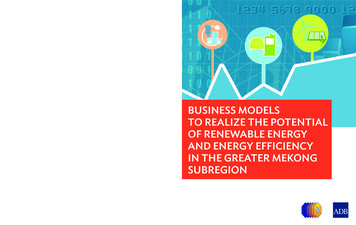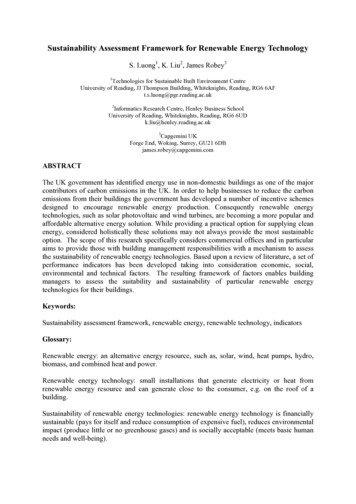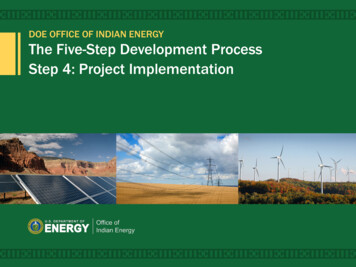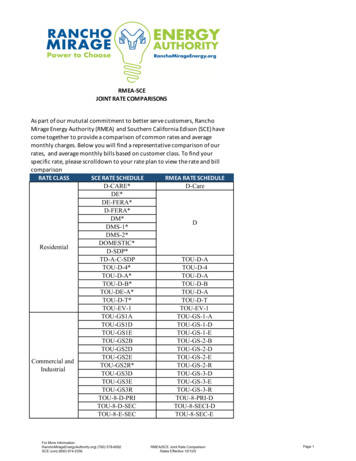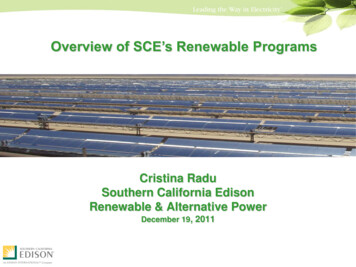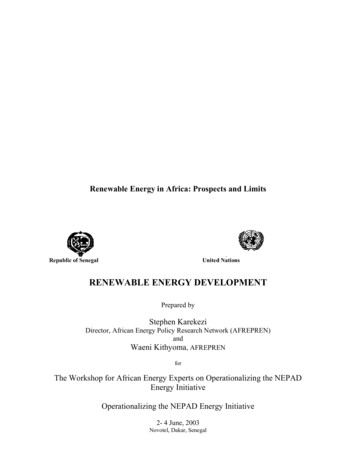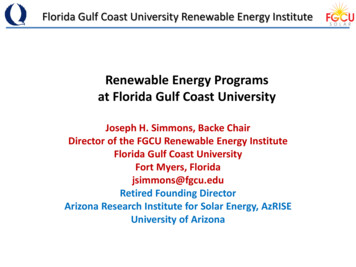
Transcription
Florida Gulf Coast University Renewable Energy InstituteRenewable Energy Programsat Florida Gulf Coast UniversityJoseph H. Simmons, Backe ChairDirector of the FGCU Renewable Energy InstituteFlorida Gulf Coast UniversityFort Myers, Floridajsimmons@fgcu.eduRetired Founding DirectorArizona Research Institute for Solar Energy, AzRISEUniversity of Arizona
Florida Gulf Coast University Renewable Energy InstituteFGCU 2 MW installationSingle-axis tracking, polysilicon modules from Mitsubishi15 acres, 2 MW with 4 inverters. The field provides 60%electrical power to 3campus buildings.We study power and energy performance under SW FL skies – Annual Energy Production 2,600 kWh AC per kW DC name-plate rating. Modeling single-axis-tracking flat plate PV
DOE Multi-Model, Machine-Learning Solar Forecasting - OverviewIBM – NOAA – ANL – NREL – Northrop Grumman – UA/AzRISE/FGCU – NEU – TEP – Green Mountain - Petra –JUWI – Prime Solutions – 3-TIER - ISO NE – CAL ISONOAA Surfrad/ISISDOE ARM1st Solar Plant (Smyrna, TN)Integration:Website setupForecast report generation using IBMCognos linked to databaseModeling PV installations (FGCU)PV Power ValidationGMP Test Site Survey and ForecastTEP Site visit survey and preparation forhistorical data and real-time datatransfer (UA)Developing regional forecast strategiesClose this LoopIntroducing IBM MMT Techfor solar plant modelingIrradiance-Power modeling with forecastedirradiance / temperature (UA/FGCU)First PV Power forecast onlineIllustration of info blending- Site dependent blending- Use of blending for forecastThree Model BlendingSubstantial ( 20%) improvementModel blending based onsimplistic weathercategorization.Weather categorizationstrategiesForecast based onpersistence and climatology(ANL)Compact sky cameraClimatologycapable of direct sunimagingmodelEstablish initial RT modelRT model improvementSpectral dependent calculationVM SetupDB (Informix) setupDaily RAP/HRRR inputDaily NAM inputPhysical InfrastructureAutomated data processing andfeeding to database.GOES Cloud AnalysisAdvection based cloudfield forecastRAPHRRRNAMSREFNASA MODIS
Florida Gulf Coast University Renewable Energy InstituteExisting AzRISE Solar Fields - TEP Solar Test Yard: flat plate and CPV technologies
Florida Gulf Coast University Renewable Energy InstituteFGCU Solar Energy ParkOutdoor test facility:PV testing – Solar Hot Water – Solar Desalination – Energy Storage – Solar Forecasting – BiofuelsOutreach – Education and hands-on training – Visitors Park – Demonstration and testing of new devicesShared instrumentation and weather stationSolar-electric vehicle shuttle bus to campus
Florida Gulf Coast University Renewable Energy InstituteFlow Battery & PV ArrayPower Output (5 kW)500045004000350030002500200015001000500Power (W)050004500400035003000250020001500100050005kW pv Energy StorageMeasurements of powerproduced from a hybrid PVbattery system under variousconditions of load and weatherintermittencies show that thezinc-bromide flow battery cansupport the PV output to makesolar electricity dispatchableand time shifted.The operational rangesindicate a need to improvedesign and operationalconditions. But theperformance of the batteryclearly supports its promise asa major component of futuresolar PV systems that requiresome measure ofdispatchability.
Florida Gulf Coast University Renewable Energy InstituteEnergy Storage3-stage BauerCompressor- Thermodynamic analysis of efficiency with and without compression inter-cooling- Build and test compressor operation with heat exchange system- Build and test expansion turbine- Evaluate reduction in NG consumption due to thermal management
Florida Gulf Coast University Renewable Energy InstituteSolar Economics!!! Is Solar too expensive for the Sunshine State? The cost of a PV system today: (very approximate figures)oooooo 0.85/watt for the modules 0.25/watt for the inverter 0.10/watt for other electrical components 1.50/watt for installationTOTAL 2.70/watt installed (2012) Today - 2.00/watt (NO REBATES)A good installer will produce 2,000kWh/kW (AZ) and 1,500kWh/kW (FL)annually. This translates to 1.35/kWh (AZ), 1.80/kWh (FL)o If amortized over 20 years, then the cost per year is well below the retailprice of electricity ( 0.12/kWh – grid price)Solar AZ - 0.07/kWh and Solar FL - Bio0.090.110.070.100.110.100.07*0.310.100.11Energy Information Agency 2011except for Solar PV
Florida Gulf Coast University Renewable Energy InstituteOngoing Projects FGCU 2MW Solar Field – Performance under SW Florida skies Solar power forecasting (DOE/IBM)o Modeling Single-Axis-Tracking flat-plate PV systems Energy Storageo Testing novel storage devices (flow batteries and supercapacitors)o Development of small-scale Compressed Air Energy Storage Solar economics – Critical to FloridaSolar multistage desalination and water treatment (NFWF)Sandia multijunction solar cellsConstruction of I-Hub Research Park and FGCU Solar ParkCollaboration with Algenol on algae-based ethanol productionDevelopment of Renewable Energy Engineering degreeOutreach and regional economic development
Florida Gulf Coast University Renewable Energy Institute Solar Economics!!! Is Solar too expensive for the Sunshine State? The cost of a PV system today: (very approximate figures) o 0.85/watt for the modules o 0.25/watt for the inverter o 0.10/watt for other electrical components o 1.50/watt for installation o TOTAL 2.70/watt installed (2012) Today - 2.00/watt (NO REBATES)


